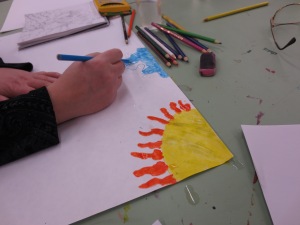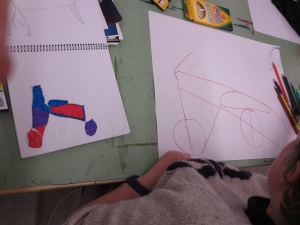Lesson Description: Students will be creating pieces of 2-dimentional artwork that show a memory they have of an outdoor activity. They will get a chance to use any of the materials we had shown them in the past lessons. We hope for them to focus on telling a story with their pieces and expressing emotion through learned techniques. We also hope that since the students are given a variety of materials that they will experiment with mixed media and the potential that mixed media can bring to a piece. They will get a chance to reflect on their artwork at the end of the class by sharing their artwork with their class mates and telling them the techniques they used and why.
Key Concepts: Symbol, technique, line, expression, emotions, movement, shape, and color
Essential Understandings: -Art can be made to symbolize a memory and express what it means to an artist personally. -Movement can be expressed in works of art using line and shape. -Different techniques can be learned and applied with color to create a sense of emotion in art.
Objectives:
- -After brainstorming, students will create a concept map about an outdoor activity they enjoy. (Bloom’s: applying/ Standard: Transfer/ GLE: 4th )
- -Using concept map, students will be able to sketch a 2 dimensional plan for a piece of art representing an outdoor activity they enjoy. (Bloom’s: applying/ Standard: Transfer/ GLE: 4th )
- -Given variety of materials, students should be able to create a 2 dimensional piece of artwork using the chosen materials that will be best to represent their idea. (Bloom’s: Create/ Standard: Create/ GLE: 4th Create 1)
- -Using provide information about artists, students will do research by collecting pieces of artwork and important facts to find artists that use the similar subject matter or techniques they plan to use. (Bloom’s: understanding/ Standard: Transfer/ GLE: 4th Comprehend 1)
- -Using completed work, students should be able to explain the different processes they used and describe their decisions. (Bloom’s: analyzing and understanding/ Standard: Transfer/ GLE; 4th Transfer 1)
Skills: Correct use of materials and exploration of mixed media.
Art Focus: Mixed media; technique and expression
Literacy Focus: To be able to share a memory in their artwork. Also to be able to describe their reasoning for why they chose certain materials and techniques.
Documentation:
Today was the final service learning session. For our final activity the students were asked to create a piece of artwork based around an activity they liked to do outside. They were allowed to use any of the mediums we had used in the previous weeks. We also had the students use a large piece of paper to create their artwork on. Most of the students were excited about this and those that wanted to still work smaller still had the option. To get them to start brainstorming ideas we asked volunteers to share activities they liked to do outside. Jim mentioned he liked to mow the yard and Ashley talked about horseback riding. We then answered any questions they had and let them start sketching ideas in their sketchbooks.


LeeAnn really took advantage of the planning stage. She created a detailed sketch of what she would later transfer to her larger piece of paper. This has been an important stage for LeeAnn through the last five weeks. She really uses the planning stage to think about her ideas. This week when she was done drawing her idea she made a decision on what mediums to use and then was able to start her large piece with no troubles.


When we gave students the option to use any of the previous mediums, we hoped they would experiment with mixed media. To initiate the use of mixed media myself and Missy chose to mix media in our examples that we shared with the students. We also talked about mixed media with the students so they understood it was an option for them. Judy was one of the students who used mixed media in her artwork. She explained that she liked adding the magazine images to her artwork because it was easy to cover the empty spaces. Another student who used mixed was Heidi. She used the mosaic technique by ripping up colored paper and using the pieces to create the mountains in her artwork. She then used watercolors to create the river in her artwork.


While I was walking around to see what ideas the students were coming up with, Becky expressed an idea about a bike but she wasn’t sure how to draw a bike. I helped Becky to solve her problem by breaking down the basic shapes of a bike. While deciding the basic shapes we also thought about the placement of these shapes and how and where they all connected. Through this process Becky was able to come up with an image that resembled a bike for her artwork.

As always we had a few students who didn’t complete the activity that we assigned for the class. Instead they created other pieces of artwork. Lisa had done a small piece of artwork for the activity but then became more involved with creating another image of a koala bear that resembled the one she had made the week before. Anni also didn’t complete the assignment but she created many watercolor paintings of stick figures. She has done this continually through most of the class sessions. Even though Anni didn’t complete the assignment she seemed very delighted with the artwork she was making and the subjects in the artwork. Chris also chose to create artwork about things he enjoyed instead of completing the assignment this week.



Brian didn’t create anything but continued to work in his sketchbook like he had all five class sessions. Even though Brian didn’t participate in the classroom activities we were still able to make connections with him. Also he was a learning opportunity for us because in the future we may have a student who just don’t want to do our assignments and we will have to learn how to handle that.
Since the class activity was to create a piece of artwork about something the students liked to do outside we decided to have our reflection time outside. This was a nice way to end our last class session with the students. We were able to enjoy the nice weather and talk about their artwork. We also asked the students to tell the group about the activity they were depicting and the mediums they used. We also asked that the students share with us and the group what their favorite activity from the class sessions. This was a fun reflection because we got the chance to learn more about our students as well as learn what activities they liked. In the end I feel that even though we had a bumpy start to the first two class sessions, we were really able to give the students a great experience. They also made it a great experience for us.























